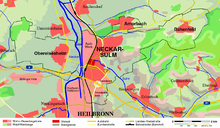Federal model settlement
For federal model settlement that from May 1, 1953 newly built settlement was on October 27, 1953 Amorbach by the speaker of the federal housing ministry says Breitmeyer.
History of origin
As early as May 1949, the Heilbronn District Office began to consider a larger settlement with a central location to the cities of Heilbronn and Neckarsulm . In 1950 the district of Heilbronn had 139,332 inhabitants, including 20,840 displaced persons . Most of the displaced were housed in smaller communities in the district. The problem was that many employees had to commute long distances to their workplaces in Heilbronn and Neckarsulm . In September 1950 there were 14,800 commuters (old and new citizens).
Therefore, from May 1951, the Neckarsulm local council discussed the development of the area in the Amorbacher Feld . After numerous discussions, the decision to build the new Amorbach district was made on June 3, 1952. On August 26, 1952, the city bought a 20- hectare site in Amorbacher Feld from the Württemberg Forestry Directorate , part of which was on the Oedheim and Friedrichshall markings . The Stuttgart architect Helmut Erdle, who won the planning competition, was commissioned with the final design on August 29, 1952.
In March 1953, the development work (road construction, laying of water pipes) began, and on May 1, 1953 the first groundbreaking was carried out by Fritz Ulrich , then Minister of the Interior of Baden-Württemberg . In the first construction phase, a total of 543 apartments were built by four large building cooperatives from May 1953. In detail were built:
- 105 apartments by the Neckarsulm home cooperative
- 124 by the settlement agency of the Rottenburg-Stuttgart diocese
- 135 apartments by the non-profit settlement society of the aid organization of the Evangelical Churches in Germany, Stuttgart and
- 179 apartments and eight shops by the non-profit Württemberg housing company Stuttgart
From March 1954, another 239 apartments were built in the second construction phase, again by four building cooperatives:
- 119 commercial houses and 17 rental apartments by the non-profit cooperative of self-residents Stuttgart
- 38 houses for sale by the Neckarsulm Home Cooperative
- 40 rental apartments by “Selbsthilfe”, a non-profit settlement and housing association for people who have been displaced and injured Stuttgart and
- 30 rental apartments (high-rise) by the non-profit Württemberg housing company Stuttgart
Today's Alt-Amorbach was inaugurated on September 24, 1955.
Significance of the federal model settlement
The new settlement in Amorbacher Feld was built with the aim of alleviating the housing shortage after the Second World War and providing a new home for commuters and displaced persons. It was considered beneficial that the area could be built over in one go. At the topping-out ceremony for the apartments of the first construction phase on October 27, 1953, the spokesman for the Federal Housing Ministry Breitmeyer declared the estate to be a “federal experimental construction project” and thus a federal model estate . His reasoning was that "it will bring valuable knowledge in terms of architecture and construction technology".
The settlement was designed by the architect Helmut Erdle not as a settlement, but as a small town. The new district was arranged with all necessary facilities in the form of a large "T". The crossbeam in east-west direction is formed by the school with a gym, a kindergarten, a Catholic and a Protestant church. In a north-south direction runs a commercial street, the "Amorbacher Straße", with all important supply facilities.
The construction of this model estate was based on the latest experience and knowledge of the building industry, so that from mid-1953 onwards, interested parties from all over Germany came to see this new - emerging - settlement.
literature
- Bernd Friedel: 50 years of Amorbach - the district through the ages. , Publisher: Stadt Neckarsulm, Druck- und Verlags-GmbH Welker, Neckarsulm 2005
- Barbara Griesinger (Red.): Neckarsulm. The story of a city . Edited by the city of Neckarsulm. Konrad Theiss Verlag, Stuttgart 1992, ISBN 3-8062-0883-2
- Anton Heyler: Chronicle of the City of Neckarsulm 1951 to 1976 , published by Stadt Neckarsulm, Neckarsulm 1989
Web links
- History and historical pictures of Amorbach on the Internet site of the Amorbach Sports Club
Individual evidence
- ↑ Bernd Friedel: 50 Years of Amorbach , Neckarsulm 2005, pp. 7–9
- ^ Anton Heyler: Chronicle of the City of Neckarsulm 1951 to 1976 , Neckarsulm 1989, pp. 31-40
- ↑ Barbara Griesinger (Red.): Neckarsulm. The history of a city , Stuttgart 1992, pp. 360–363
- ^ Anton Heyler: Chronicle of the City of Neckarsulm 1951 to 1976 , Neckarsulm 1989, p. 40
- ↑ Bernd Friedel: 50 Years of Amorbach , Neckarsulm 2005, pp. 8–9
- ^ Anton Heyler: Chronicle of the City of Neckarsulm 1951 to 1976 , Neckarsulm 1989, p. 37
Coordinates: 49 ° 12 ′ 44.3 " N , 9 ° 14 ′ 59.6" E

